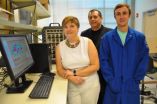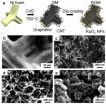(Press-News.org) RIVERSIDE, Calif. — Researchers at the University of California, Riverside have developed a novel nanometer scale ruthenium oxide anchored nanocarbon graphene foam architecture that improves the performance of supercapacitors, a development that could mean faster acceleration in electric vehicles and longer battery life in portable electronics.
The researchers found that supercapacitors, an energy storage device like batteries and fuel cells, based on transition metal oxide modified nanocarbon graphene foam electrode could work safely in aqueous electrolyte and deliver two times more energy and power compared to supercapacitors commercially available today.
The foam electrode was successfully cycled over 8,000 times with no fading in performance. The findings were outlined in a recently published paper, "Hydrous Ruthenium Oxide Nanoparticles Anchored to Graphene and Carbon Nanotube Hybrid Foam for Supercapacitors," in the journal Nature Scientific Reports.
The paper was written by graduate student Wei Wang; Cengiz S. Ozkan, a mechanical engineering professor at UC Riverside's Bourns College of Engineering; Mihrimah Ozkan, an electrical engineering professor; Francisco Zaera, a chemistry professor; Ilkeun Lee, a researcher in Zaera's lab; and other graduate students Shirui Guo, Kazi Ahmed and Zachary Favors.
Supercapacitors (also known as ultracapacitors) have garnered substantial attention in recent years because of their ultra-high charge and discharge rate, excellent stability, long cycle life and very high power density.
These characteristics are desirable for many applications including electric vehicles and portable electronics. However, supercapacitors may only serve as standalone power sources in systems that require power delivery for less than 10 seconds because of their relatively low specific energy.
A team led by Cengiz S. Ozkan and Mihri Ozkan at UC Riverside are working to develop and commercialize nanostructured materials for high energy density supercapacitors.
High capacitance, or the ability to store an electrical charge, is critical to achieve higher energy density. Meanwhile, to achieve a higher power density it is critical to have a large electrochemically accessible surface area, high electrical conductivity, short ion diffusion pathways and excellent interfacial integrity. Nanostructured active materials provide a mean to these ends.
"Besides high energy and power density, the designed graphene foam electrode system also demonstrates a facile and scalable binder-free technique for preparing high energy supercapacitor electrodes," Wang said. "These promising properties mean that this design could be ideal for future energy storage applications."
INFORMATION: END
Improved supercapacitors for super batteries, electric vehicles
Researchers develop novel supercapacitor architecture that provides 2 times more energy and power compared to supercapacitors commercially available today
2014-05-19
ELSE PRESS RELEASES FROM THIS DATE:
Is Duloxetine more or less effective than Fluoxetine in children and teens with MDD?
2014-05-19
New Rochelle, NY, May 19, 2014—Two studies of the anti-depressive drug duloxetine, a serotonin-norepinephrine reuptake inhibitor (SNRI), compared its effectiveness and safety to either fluoxetine or placebo in children and adolescents with major depressive disorder (MDD). The results of these first controlled trials of duloxetine in pediatric patients with MDD are published in Journal of Child and Adolescent Psychopharmacology, a peer-reviewed journal from Mary Ann Liebert, Inc., publishers. The articles are available free on the Journal of Child and Adolescent Psychopharmacology.
Graham ...
Children who exercise have better body-fat distribution, regardless of their weight
2014-05-19
URBANA, Ill. – Maybe the numbers on the scale aren't alarming, but that doesn't mean that healthy-weight children get a pass on exercising, according to a new University of Illinois study published in Pediatrics.
"The FITKids study demonstrates the extent to which physical activity can improve body composition, and that's important because it matters to your health where fat is stored. But the study is also interesting for what happened in the control group to the kids who didn't exercise," said Naiman Khan, a postdoctoral researcher in the U of I's Division of Nutritional ...
New 'T-ray' tech converts light to sound for weapons detection, medical imaging
2014-05-19
ANN ARBOR—A device that essentially listens for light waves could help open up the last frontier of the electromagnetic spectrum—the terahertz range.
So-called T-rays, which are light waves too long for human eyes to see, could help airport security guards find chemical and other weapons. They might let doctors image body tissues with less damage to healthy areas. And they could give astronomers new tools to study planets in other solar systems. Those are just a few possible applications.
But because terahertz frequencies fall between the capabilities of the specialized ...
Study shows dementia patients benefit from holistic exercise program
2014-05-19
Philadelphia, PA, May 19, 2014 – While dementia patients can often suffer from depression and declining physical and mental ability, exercise has been shown to help improve both their physical and psychological wellbeing. Researchers at Teesside University in the U.K. investigated how combining cognitive activities and elements of yoga, tai chi, qigong and meditation with routine physical exercise affected dementia patients. They found that a holistic exercise program focusing on both mind and body can help improve quality of life for dementia patients. Their findings are ...
Optical brain scanner goes where other brain scanners can't
2014-05-19
Scientists have advanced a brain-scanning technology that tracks what the brain is doing by shining dozens of tiny LED lights on the head. This new generation of neuroimaging compares favorably to other approaches but avoids the radiation exposure and bulky magnets the others require, according to new research at Washington University School of Medicine in St. Louis.
The new optical approach to brain scanning is ideally suited for children and for patients with electronic implants, such as pacemakers, cochlear implants and deep brain stimulators (used to treat Parkinson's ...
Skunk Fire, Arizona
2014-05-19
The Skunk Fire continues to burn on the San Carlos Apache Reservation in southeastern Arizona and NASA's Aqua satellite captured an image of the smoke on May 17 at 20:15 UTC (4:15 p.m. EDT/1:15 p.m. MST). A Fire Weather Watch has been posted for the region for May 20.
The Moderate Resolution Imaging Spectroradiometer or MODIS instrument that flies aboard NASA's Aqua satellite captured this photograph of the smoke. The extent of the fire (the heat) is outlined in red in this image).
According to Inciweb, the multi-U.S. agency Incident Information System website that ...
Gastroenterology highlights new microbiome research
2014-05-19
Bethesda, MD (May 19, 2014) — The editors of Gastroenterology, the official journal of the American Gastroenterological Association (AGA) Institute, are pleased to announce the publication of this year's highly anticipated special 13th issue on the intestinal microbiome, which is considered one of the hottest areas of science today.
"We are beginning to understand the ways by which the microbial environment of the gut may play a role in both the maintance of human health and the development of certain diseases. Data in this special issue of Gastroenterology may lead ...
Liberating devices from their power cords
2014-05-19
Imagine a future in which our electrical gadgets are no longer limited by plugs and external power sources.
This intriguing prospect is one of the reasons for the current interest in building the capacity to store electrical energy directly into a wide range of products, such as a laptop whose casing serves as its battery, or an electric car powered by energy stored in its chassis, or a home where the dry wall and siding store the electricity that runs the lights and appliances.
It also makes the small, dull grey wafers that graduate student Andrew Westover and Assistant ...
Having and raising offspring is costly phase of life for baboon moms
2014-05-19
Observations made over the past 29 years in Kenya as part of one of the world's longest-running studies of a wild primate show how having offspring influences the health of female baboons. These observations highlight that females are mostly injured on days when they are likely to conceive. In addition, injuries heal the slowest when they are suckling their young. The study, published in Springer's journal Behavioral Ecology and Sociobiology, is led by Elizabeth Archie of the University of Notre Dame in the US and the National Museums of Kenya.
Reproduction can be dangerous ...
UT Dallas lab eliminates rare metals in electric motors
2014-05-19
A team from the Renewable Energy and Vehicular Technology Laboratory(REVT) at UT Dallas was one of a few research groups selected for advanced participation in a Department of Energy conference aimed at presenting the next generation of energy technologies.
The DOE's Advanced Research Projects Agency-Energy (ARPA-E) program hosts an annual summit in Washington, D.C., for researchers, entrepreneurs, investors, corporate executives and government officials to share transformational research funded through the program.
Dr. Babak Fahimi, professor of electrical engineering ...
LAST 30 PRESS RELEASES:
School meals could unlock major gains for human and planetary health
Menopause hormone therapy does not appear to impact dementia risk
Signature patterns of brain activity may help predict recovery from traumatic brain injury
Dresden study uncovers new key mechanism in cancer cells
New species are now being discovered faster than ever before, study suggests
Cannabis-based products show limited short-term benefit for chronic pain, with increased risk of adverse effects
Cannabis products with more THC slightly reduce pain but cause more side effects
Clearing the brain of aging cells could aid epilepsy and reduce seizures
Brain injuries linked with potential risk of suicide, new study finds
New technique lights up where drugs go in the body, cell by cell
New study finds movement of fishing fleets can reveal shifts in marine ecosystems
Embargoed: New evidence points to potential treatment for vascular dementia
Study uncovers disrupted brain balance in alcohol dependence
Working in groups can help Republicans and Democrats agree on controversial content moderation online
Structural findings reveal how distinct GPCR ligands create different levels of activation
Anything-goes “anyons” may be at the root of surprising quantum experiments
UC review: Maximizing workplace opportunity for veterans
From generation to complex control: Metasurfaces make perfect vortex beams "within reach"
Thin-film lithium niobate-based detector: recent advances and perspectives
Exploring why some people may tend to persistently make bad choices
How cells balance their protein levels
Nirsevimab vs RSVpreF vaccine for RSV–related hospitalization in newborns
Effectiveness and impact of maternal RSV immunization and nirsevimab on medically attended RSV in US children
AI gives scientists a boost, but at the cost of too many mediocre papers
Next-generation vision model maps tree growth at sub-meter precision
Genes aren’t destiny for inherited blindness, study shows
MIT study: High-fat diets make liver cells more likely to become cancerous
Exposure to multiple fine particulate matter components and incident depression in the US Medicare population
Risk of burdensome health care spending over time in the US
Nirsevimab against hospitalizations and emergency department visits for lower respiratory tract infection in infants
[Press-News.org] Improved supercapacitors for super batteries, electric vehiclesResearchers develop novel supercapacitor architecture that provides 2 times more energy and power compared to supercapacitors commercially available today





